With the rise of nutrient deficiencies and chronic stress, more people than ever are experiencing thinning hair and bald spots. Here’s how to identify what type of hair loss you have, plus how to do evidence-based head massage for hair growth so you can reverse it!
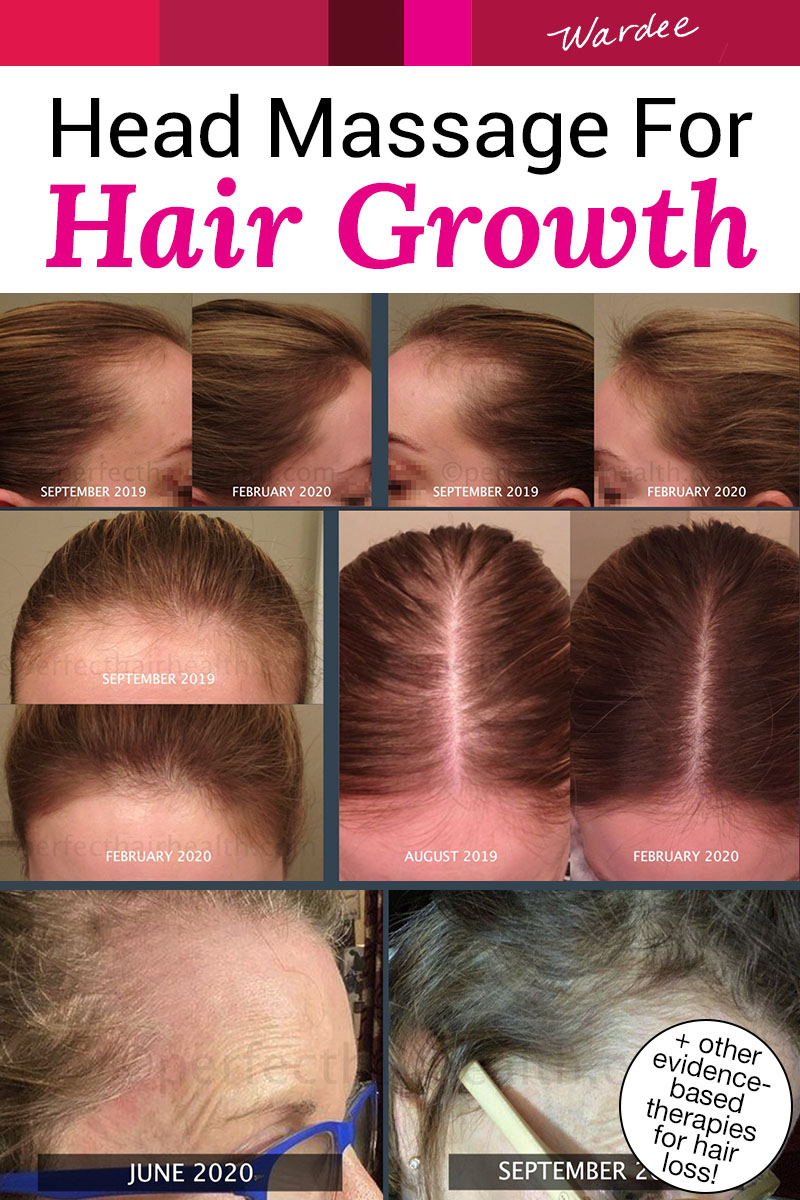
If you’re experiencing hair loss and it seems like nothing is working…
…it’s probably because YOU have unique causes(s).
No matter what the TV commercials say, hair loss solutions are NOT one-size-fits-all.
And with the rise of nutrient deficiencies and chronic stress, more people than ever are experiencing thinning hair and bald spots, yet not getting help. 🙁
So I’m excited to welcome Rob English from Perfect Hair Health to discuss hair loss… and specifically how head massage can help thinning hair.
Rob is a medical editor and peer-reviewed researcher specializing in hair loss disorders.
It all started for him fourteen years ago as a high schooler, when he was diagnosed with androgenic alopecia, or male pattern hair loss.
Since then, he has reversed his hair loss and worked with thousands of other people to help them reduce or reverse hair loss, too. Like Jenna:
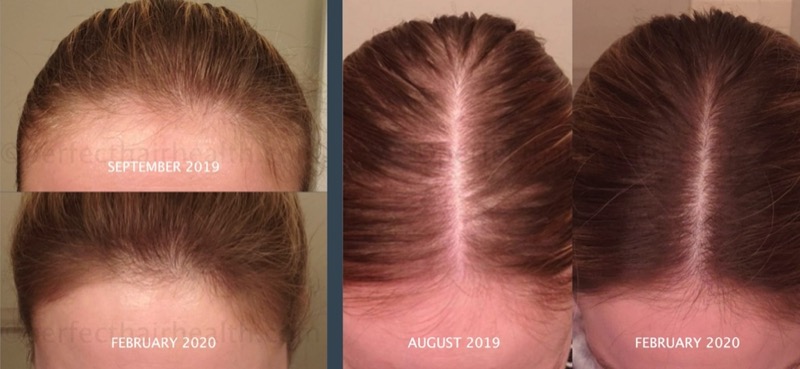
If you or someone you know has thinning hair… then please listen to — or read or watch — this podcast interview with Rob English from Perfect Hair Health to learn about evidence-based methods of hair regrowth (with or without drugs) and how to treat hair loss effectively!
As just a side note for anyone working with me and using the non-toxic hair regrowth products I recommend (and use myself): they work very well with the tips Rob and I discuss here! Go here to see.
In this article:
- identifying hair loss …all the possible reasons so you can pick the most effective treatment
- how to reverse hair loss …head massage for hair growth (video and download included), diet, lifestyle changes, etc.
- hair regrowth products and supplements to stay AWAY from …don’t believe everything you read
- what the typical hair regrowth process looks like …what to expect
- and more!
Please set aside distractions and watch or listen to the video below. Or, if you prefer to read, I captured the gist of our interview in the cleaned up notes below (or you can download the complete transcript)!
Wardee: Hi, everyone. I'm so glad you joined me today, and so has Rob English. Hi, Rob.
Rob: Hi, it's nice to meet you, Wardee.
Wardee: Great to meet you too. Everyone, I'm so excited to have Rob on here today. I bumped into him... Actually, my husband found you, Rob. A couple of months ago, you were a guest on a podcast we listen to, and my husband was like, "Wardee, you need to check this out because you help people with hair. And I think you need to know this." So anyway, we listened. And everyone, I'm going to let Rob tell his story, but just very briefly...
[00:00:30] Rob is a researcher, medical editor. He's the founder of his website called Perfect Hair Health. And on his website, he dedicates himself to showing evidence-based methods for hair regrowth with or without drugs. He actually has a wonderful story, which he's going to tell you of his own hair loss journey that started 14 years ago. And since then, he's worked with a lot of people, actually thousands to help them reverse their own hair loss. And he has a lot of success stories on his website, including photos, which check [00:01:00] out when you have time.
And today, I invited him on my podcast just to talk more about his methods for hair regrowth, but in particular, I'm really interested in you sharing, Rob, more about hair massage. So, hopefully, we'll be able to talk about that. So, I'm going to turn it over to you, Rob, if you would share more of your story, so our listeners can get insight into where you're coming from.
Rob: Sure. Well, thank you for having me on the podcast. [00:01:30] Just to reiterate a bit about what you said. My name is Rob English. I am a medical editor, specializing in hair loss disorders. I'm a peer reviewed researcher. I have published publications about hair loss disorders in terms of its pathophysiology, in terms of some hypotheses, some secondary accelerators of hair loss, even some interventions that are lesser known.
And I also run the website, perfecthairhealth.com, which showcases those evidence-based approaches for hair loss [00:02:00] reversal with the drug model, without the drug model. It doesn't really matter what pathway somebody takes for me, what matters is their access to unbiased information.
And if you asked me 15 years ago, what I would be doing with my life, hair loss research was probably the last thing on my mind, because back then I was just a high schooler. And yet I was in class one day, 16 years old, and I was sitting down, and this girl behind me poked my head and notified me, "You have a bald spot." [00:02:30] And so, I laughed it off. It was a little bit psychologically disconcerting.
And so, I ended up booking an appointment with a hair loss specialist in New England, who happened to be the top hair loss specialist in New England at the time. And I went to his office, met with his consultation officer, and then met with him himself. And he took a look through my hair and he did a scalp examination. And he told me that I have male pattern, hair loss, also known as androgenic alopecia. And that this was a chronic progressive hair loss disorder. [00:03:00] And that without treatment, it would only worsen. And it was a bit devastating for me at the time, because when I would visually inspect my friend's hair, IT seemed like I was the only person that I knew that was facing this condition.
And so, Dr. Leonard ended up walking me through my treatment options, which at the time he noted me were to try taking Propecia or Finasteride. That's a DHT reducer. It's a type of drug that can help lower a hormone causally [00:03:30] linked to the progression of male pattern hair loss. He also said that I could apply minoxidil or Rogaine twice daily. And that this drug acted like a hair growth stimulant. It has vessel dilation properties. It's a prostaglandin modulator. People don't necessarily know exactly how it works, but it seems to work to improve hair counts overall for men and women trying it.
And then he also ran through some secondary and tertiary options for me. So, I could start with laser [00:04:00] caps, like low laser therapy. I could do a hair transplant, depending on how bad things progressed. But all this felt really overwhelming, because at the time I was a high schooler with a job as a summer camp counselor. Most of these options like hair transplantations really weren't affordable to me.
And I was also really, really afraid about lowering this hormone DHT, because I didn't really understand its significance biologically, and I also was going to [00:04:30] compete in athletics for a division one collegiate sports. And so, I got very nervous about the idea of lowering this male hormone that I had read articles about online. It's apparently a pretty potent testosterone metabolite. And the idea of going down that route and becoming beholden to a drug that would certainly improve my hair loss significantly, stop the progression of male pattern hair loss in 80% to 90% of men who take it, and evenly to attend [00:05:00] to 20% increase in hair counts, depending on the study you're citing, I just was really nervous about doing this.
And when I went online to research that drug itself, I ran into a ton of misinformation about the real risks of side effects and prolonged side effects that people can experience, and all these other things that sound like horror stories when you're reading them, that would absolutely scare you away from using this medication that happens to have gone through an incredibly rigorous FDA approval trial period, [00:05:30] and is really well studied in thousands and thousands of men, and where the concerns of this are really overstated.
Nonetheless, my exposure to this misinformation scared me to the point where I completely avoided that drug entirely. And it sent me on this mission to try and find options outside of the drug model. And the long story short is that I ended up spending six years and over $10,000 on hair loss products that were really well-marketed, looked really [00:06:00] promising. But that as my acumen scientifically began to increase in hair loss research, I later learned were mostly scientifically baseless.
And if we take a step away from my story for a moment, and we just think about the landscape of hair loss research out there right now, I think that hair loss in itself is a really unique industry. I think that it is one of the only industries whereby profit incentives disadvantage consumers [00:06:30] at multiple levels, at the online level, at the doctor's office, and at a dermatologist appointment, and for entirely separate reasons.
So, say you start losing your hair and you’re concerned. And so, you try to type into Google what causes hair loss. Well, Google doesn't necessarily prioritize top medical information. And you'll end up getting these listicles from really popular health websites, that claim to be medically [00:07:00] reviewed, things like healthline.com, Medical News Today. And you'll read about how hair loss is caused by something like an iron deficiency or a biotin deficiency, or an omega fatty acid deficiency, or an imbalance in selenium and vitamin A. So, you read this and the articles happen to attach citations that you can then click into, but very rarely anybody ever does. And then they attach themselves to affiliate marketing. So, you end up with this belief, "Oh man, [00:07:30] if hair loss is caused by a biotin deficiency and I'm losing my hair, and this really high ranking Google article is telling me that biotin can help with hair growth. And they're citing a study to this. Well, I'm going to click into this affiliate link and I'm going to buy biotin for hair growth."
And so, this is the environment that I began to find myself in. And what isn't communicated effectively to consumers is that there's all truth to some of these causes [00:08:00] of hair loss. Certainly biotin deficiencies are associated with hair loss. In some cases, they're causally linked to hair loss. But if you actually took the time to click into that resource and read what it said, you would find out that the study that, that healthline.com, Medical News Today, or other top ranking article mentioned, you would find out that that study was on children in the developing world, something known as a bio-tinnitus deficiency, which is a genetic mutation that occurs [00:08:30] in one out of 110,000 individuals to the severity by which it will actually trigger hair shedding.
And when you give these children biotin, they can overstep that enzymatic deficiency, that's genetically ingrained to them, so that now they can begin to grow hair normally. So, you're taking information about a very specific type of hair loss, and you're communicating it outward to the general population, whereby in most cases, those [00:09:00] causes do not apply to them. And yet biotin supplements for hair loss sell hundreds of millions of dollars every single year. Most people are under the impression that they're incredibly important. Almost everybody that I work with, men and women who we sit down and have a consultation together, will tell me that they are supplementing at a minimum with biotin.
And so, that's what you face at an online level, these affiliate marketing profit incentives to basically not tell you the whole story, so you can buy things like supplements.
[00:09:30] Now, say you don't make that Google search and you end up going to a doctor, which is in many cases, a way better resource. Well, doctors are also limited in how much they can help you, mainly because they're profit incentivized to keep their doors open. And they're incredibly, incredibly busy. Most doctors work just shy of 60 hours per week. They manage if they're a family physician, a panel of 2300 [00:10:00] patients. And new physician patient time is merely eight minutes long. And physician burnout was almost 50%. And that was in 2019 prior to the pandemic. So, imagine what those numbers are now.
So, in order for a doctor to fully evaluate your hair loss situation, they actually need a ton of time with you. And usually what ends up happening is that because patient interaction points are so short and because they're so capped on [00:10:30] time, they end up typically prescribing drugs like Finasteride and minoxidil, which can absolutely work for a majority of cases, but they never really have the time to do those full health evaluations to determine if other causes of hair loss that you're facing might relate back to subclinical hypothyroidism, or some sort of low grade widespread nutrient deficiency, or gut dysbiosis. And this creates a problem because patients end up solving for just a portion of their hair loss equation, and then they get underwhelming results [00:11:00] and they don't really understand why. That's the problem at a doctor's office. And I also went through this.
So, then say, you decide to forego the online research. You decide to forego the doctor's office. And instead you transition to the cream of the crop, a dermatologist. This is a specialist in hair loss disorders. Obviously, this person is going to be the best possible resource aside from a dermatologist, specializing in hair loss that will be able to diagnose your hair loss effectively. And [00:11:30] these appointments can range around 20 minutes long. And they can do scalp biopsies and scalp analysis. And they can take micro-zoomed photos of your scalp and really get into the details here.
The problem is the dermatologists have a different set of profit incentives. They keep their doors open in many cases, by doing cosmetic procedures and offering hair loss patients, things that absolutely have clinical data and support behind them, like platelet rich plasma therapy, or stem cell [00:12:00] therapy, or stem cells plus A-cell, or even the latest thing is exosomes. These are all intro-body derived treatments, whereby your blood is extracted or a tissue of yours is extracted, centrifuged, new cells are isolated and then injected straight into your scalp.
And the clinical data will suggest that these things on average can increase hair counts, tend to 30%. The problem is they cost anywhere from a thousand dollars to $10,000, and their results are contingent upon lifelong use. And what these dermatologists [00:12:30] won't tell you is that devices like micro-needling, which look like these medieval torture devices with little spikes on them, you can order these on Amazon for literally $10. Clinical studies demonstrate that they evoke roughly the same ballpark and hair count increases. And on top of that in split scalp studies, when you look at PRP and one half of the scalp versus micro-needling, both things perform exactly the same.
And so, it's the lacking [00:13:00] information behind these alternative therapies or interventions, or the real data behind clinically FDA approved treatments that confuse hair loss sufferers. And I thought that this was bad back in 2007, when I was first diagnosed with pattern hair loss. I remember imagining this is never going to get worse than this. And unfortunately, misinformation has just exploded.
So, when I eventually found a regimen that worked really well for me and I began to prioritize [00:13:30] education and not product purchases, I started the website, perfecthairhealth.com to showcase some of the approaches that I was using, the evidence supporting them, and basically trying to guide people toward a path for hair recovery on their own terms. So, if that meant they wanted to use the drug model, great. If that meant they wanted to forego that to first try other natural interventions, great. It didn't matter to me, what mattered is that they weren't facing all of the things that I ended up burning $10,000 on, because I just lacked enough information.
[00:14:00] And eventually, this experience led me toward publishing peer reviewed publications, and then interventional studies, and then later on hypothesis, and then becoming an editorial board member of a dermatology journal. And so, that is where we are now. I now manage a small team of researchers. We pump out different publications every year. We've got several peer reviewed publications, a couple coming out later this year. And that is the state of what our website is, who I am [00:14:30] and what brought me here.
Wardee: That is fabulous. You covered a lot of ground in that. And I just want to say congratulations for... Well, I mean, the thing is, we suffer in different ways, and your suffering with hair loss led you down this path of success, both in reversing your hair loss and bringing you to a career you never foreseen and helping thousands. So, I call it a win. I mean, I'm on the outside [00:15:00] looking in, but I would think what a blessing, and I'm grateful that you're sharing with us.
And what you said about doctors and dermatologists, and online, you're so right. I mean, it's not a cookie cutter, one size fits all. Very simple thing is, I have curly hair and if I listened to other people's advice about what to do with curly hair, which I've tried, it just 99% of the time, it's like, "Nope, it doesn't work for me." I had to find my own way. And I think the same [00:15:30] is true for hair loss. So, I'm really excited for you to tell us more about that.
You were 16 and diagnosed. How long did it take you to reverse your hair loss? And we know you spent $10,000 researching different things, but where did you get to the point where it was reversed? And did you get a hundred percent back, 80% back? Where do you stand on your personal story?
Rob: Sure. So, I started seeking treatment back in 2007 when I was [00:16:00] first diagnosed. I forewent Finasteride because of all of that information that I ran into online, that biased my opinion toward not trying it. And that's what really catalyzed this entire journey. But I was using minoxidil, because that wasn't this hormone modulator. To me at the time, it felt less risky. And I wanted to do something.
I also started low level laser therapy. I did a trial of that for eight weeks. I later bought combs and devices to use at home. But the entire time that I [00:16:30] was using these products, my hair loss just continued to slowly progressively worsened. And you can see this through photos on my website. I mean, I wasn't actively taking photos of my crown throughout this entire period, but there are video clips that are available. There are photos that demonstrate that over these four year periods, where I was really sticking to just low-level laser therapy, minoxidil, different dietary interventions, different supplements, things like saw palmetto, the hair loss just continues to worsen and worsen, and worsen over time.
[00:17:00] Eventually, I stumbled upon research in the fields of mechanotransduction and mechanical stimulation, and using your own body's innate wound healing responses to begin to tackle specific things that might relate to hair cycling disorders. And I thought that research was really interesting. And so, I started to apply that research, which had some clinical basis for improving scalp hair to my own head. And this involves things related to massages, [00:17:30] micro-needling, things that actually have really similar mechanistic overlap with those other acute wound exercises offered by dermatologists, like PRP and stem cells.
And I found that over a eight to 10 month period, my hair started to significantly thicken. And this was really exciting because it was this new modality that I felt was under-researched, and that it wasn't receiving enough attention, but that also could be done at home. And it could be done [00:18:00] in a way where it's kind of a free therapy. If you do massaging while you're watching television, you're not really losing any time.
Wardee: Any time.
Rob: It's therapeutic. It's relaxing. It's stress relieving. And there is some mechanistic data to suggest that these massages might improve hair counts. And for me personally, I certainly saw that.
So, I ended up doing massages, micro-needling and other stimulation based therapies, and dropping minoxidil, and continuing with those stimulation based therapies for several, [00:18:30] several, several years. And most recently, since we've had a daughter, I haven't been as up to date with everything. So, I'm not necessarily as committed as I used to be because my time constraints are changing.
Wardee: Sure.
Rob: But to give you an idea for recovery, the best way to determine degrees of recovery are through photo tracker grants, which is basically a fancy term to describe a device that dermatologists use to measure hair counts before a treatment, and then measure hair counts after [00:19:00] a treatment. I don't have any of that data, but I do have my own self perceptions. And I also have evidence related to the photos and the videos that I demonstrate on my website and whatnot.
And so, I would estimate that I recovered probably 50% of what I had lost. Now, keep this in mind, my hair loss is not nearly as severe as other people's hair loss. And I generally had slowly progressing male pattern hair loss. And so, that 50% [00:19:30] recovery is a relative number based off of the absolute degree of hair that I lost, which was relatively minimal. But that's because I started seeking treatment the second that I noticed.
I would never want somebody to try these therapies in lieu of FDA approved drugs, because they lack information about those drugs or were exposed to the same misinformation as I was. The truth is is that those work really well for people.
And I certainly don't want people to set the expectation that because I estimate a 50% [00:20:00] recovery from my vertex, for male pattern hair loss, using these stimulation based therapies, that that should be the go-to resource for somebody. Rather, I think education is still at the basis of everything here and that if you want to target hair loss effectively, it has to be multifactorial.
But I did see what I considered to be a relatively impressive increase in hair counts that started the basis by which starting perfect hair health, to educate people on these methods. And then we ended up even launching a study at some point [00:20:30] to determine how these massage-based modalities were working for other people.
So, the study spanned a period of years, and it was a survey based study, based off of people that had been exposed to both our video demonstration on the scalp massages, as well as the PDF instruction manual for how to perform them on a regular basis. And people self-reported their results over a number of years, their minutes daily of adherence, their [00:21:00] time commitment, their months of adherence, and then their self-perceived care changes. And what we saw very definitively in the data, it was a clear relationship between the time of commitment, the minutes times the months of effort for these massages, and an improvement in self perceived hair change. And we also have a lot of before and after photos from people employing these stimulation based therapies on our website.
So again, that's not to say that we should be doing these things as a first line of defense for FDA approved drugs. [00:21:30] I don't want to give off that impression, but it is to say that they seem to have some benefit for individuals, and that a lot of people report significant degrees of hair recovery. But the degree at which somebody should expect from these natural interventions, A, should be a lot lower than your expectations for an FDA approved drug. And then B, should be relatively smaller.
Wardee: Great. So, I want to say a couple things. I appreciate you qualifying [00:22:00] you had relatively less hair loss than others, and you got 50% of it back. I think that's great. And I want to encourage our audience to go to Rob's website. He has pictures. And even though he's saying less than others, it's definitely noticeable. And what I personally would say, significantly disturbing enough to take action. You can see that in his photos. So, even though maybe you think Rob has minimizing it to be on the safe side, [00:22:30] his results are remarkable in my opinion.
So, and the second thing I want to say is, I really appreciate what I'm getting from you is that, somebody who has hair loss might go online, might visit a doctor, might visit a dermatologist, and walk away with a couple solutions of that may not be right for them. And then therefore, they're not going to get results.
So, could we now spend some time talking about [00:23:00] why it's important to identify somebody's cause of hair loss and what the possible reasons could be? Because I think the people listening here will appreciate getting some direction, unbiased direction, which is what your website provides, and some ideas of maybe things to look into. And it's in everybody's best interest to pull back from profit motive, profit motivated, or just uneducated information to be our own advocates, [00:23:30] our own researchers, so because we cannot... I know that there's people who get results going to the doctor and going to the dermatologist, but there's so many people who don't. So, we have to be educated and advocate for ourselves. And I know you're here and you have some information, so would you please share and give us some direction on that?
Rob: Sure. So, I think that this is a really important point to make. And it's one that we emphasize on our website, which is that it is absolutely critical to identify [00:24:00] the possible contributors to your hair thinning, prior to jumping into any intervention or treatment, because different types of hair loss correspond to different causes. Just like we gave that example with the bio-tinnitus deficiency and people supplementing with biotin. If you have something like female pattern hair loss, or male pattern hair loss, the likelihood of you benefiting from a biotin supplement is almost non-existent in most cases.
So, you really have to match [00:24:30] up causes, so that you can seek the right treatments, because the risk of not doing so, it means that you're going to be wasting a lot of time, a lot of money, a lot of energy, and you might lead to progressive hair loss as a consequence of that, which of course is to a degree reversible, but it's much easier to prevent the progression of male and female pattern hair loss than it is to reverse it at its end stages.
Wardee: Sure.
Rob: So, the discussion about causes are really, really important. And this is really the basis of anybody's regrowth regimen, [00:25:00] if they're choosing to seek treatment. So, when we think about hair loss, we can bucket this into a few different categories. You have hair loss that's driven by hormones. You have hair loss that's driven by stress. You have auto-immune forms of hair loss and scarring alopecia. But if we wanted to simplify this, we could bucket hair loss disorders into two big categories.
The first category is androgenic alopecia, which is male and female pattern hair loss. And [00:25:30] this is a function of a combination of genetic predisposition, exposure to male hormones. And there might be certain scalp environments that accelerate the onset of this condition as well.
But basically, this condition is so common that you can't walk down a city block without spotting somebody with it. So in men, it begins often as temple recession, and then the bald spot, which is what I had been dealing with in high school. And it's chronic and progressive. So, it generally worsens over time [00:26:00] without treatment. So, for men that will lead to a slick bald scalp.
But for women, this condition, despite linked to the same types of causes, presents a little bit differently. It generally presents as frontal temporal thinning or general finning throughout the entire top part of the scalp. And it very rarely will progress to the point where you're completely bald. It eventually stops at some points. But still nonetheless, a lot of women notice the finning and are cosmetically [00:26:30] concerned about it.
Wardee: Very.
Rob: So, the histological defining characteristic of this type of hair loss disorder is hair follicle miniaturization. So, that means that the hair strands themselves over time become thinner and thinner, and thinner. And this is unique to male and female pattern hair loss. It very rarely occurs with the exception of a couple other more rare hair loss disorders.
So, if you're facing hair follicle miniaturization, [00:27:00] if you notice that the hairs that you shed are different thicknesses and thinness, and that is a strong indication that you're most likely facing genetic and androgenic driven pattern hair loss, and that that should be the basis for these treatments.
The evidence that actually builds the basis for male hormones like testosterone and DHT being intimately involved in this process, is that [00:27:30] in the 1940s, there was this researcher, Dr. Hamilton, who was doing observational research on prisoners. And some of those prisoners happened to be male castrates. And he noticed this really clear relationship between when, if a man was castrated prior to puberty, and then went through adulthood, he would retain all of his hair. He had great hair.
Wardee: Interesting.
Rob: And if a man was castrated during adulthood, but had been balding, then the balding would stop. And [00:28:00] castration reduces testosterone, and thereby testosterone metabolized by about 95%. And so, he wrote a paper and said, "I believe that pattern hair loss is probably somehow related to male hormones like testosterone."
Later, there was research that came out of an island in Guam, Papua New Guinea, demonstrating that there was this group of men with this really rare type of genetic deficiency called [00:28:30] a type 2, 5-alpha-reductase deficiency. And that's an enzyme that converts testosterone, that male hormone, that Hamilton had identified, into another type of a testosterone metabolite called dihydrotestosterone or DHT for short. And all of these men had normal testosterone levels, but they had this deficiency that prevented them from converting that hormone into a testosterone metabolite. And interestingly enough, they had [00:29:00] no signs of pattern hair loss in adulthood. They all retained their hair. They didn't suffer from this condition that is almost ubiquitous amongst men, if you live long enough. And so, that was the next red flag, "Hey, maybe it's not just testosterone, that's the problem. Maybe it's DHT."
And then research came out, demonstrating that if you took a cell culture of human hair follicles and you bathed it in this hormone DHT, they would begin to miniaturize. [00:29:30] And that was really where causal links began to take place. And so, that's why the drug Finasteride, which reduces that activity of the enzyme type 2, 5-alpha-reductase, that's one of the reasons why it was repurposed first as a prostate medication, and then later as a hair loss treatment to lower that hormone DHT, and in doing so, slow stop or partially reverse this miniaturization process.
And the clinical data on this drug [00:30:00] for men is really impressive. In men taking it in these large scale clinical FDA approved trials, a thousand men in the treatment group, a thousand men taking the sugar pill, you see that this drug reduces levels of DHT by around 60% to 70%. It stops the progression of pattern hair loss in 80% to 90% of men. And in general, it leads to a 10% increase in hair count, alongside hair thickening [00:30:30] and the reversal of miniaturization over a two year period. And those results can sustain for as long as you use the drug. So, that was the final piece of the armor that really solidified this relationship between hormones and the onset of male pattern hair loss. So, that is the first big bucket to reiterate. I apologize for being long-winded here.
Wardee: Good details. You made the case.
Rob: Exactly. [00:31:00] Androgenic alopecia, also known as male and female pattern hair loss, driven by hormones, driven by genetic predisposition, defined through hair follicle miniaturization, the strands get thinner and thinner over time, and then treated with drugs that lower DHT in both men and women. So, that is the first category. Chronic and progressive, you have to treat it, or else it generally would get worse.
The second category, [00:31:30] the big category of hair loss disorders is something known as hair shedding disorders. And this actually has less to do, or actually nothing to do with hair follicle miniaturization, rather a hair shedding disorder happens to have everything to do with what's known as a disruption to our hair cycle.
So, our hair cycle is this naturally occurring, ever repeating phenomenon, whereby for two to seven years, every hair on our head will grow, and then it will stop growing. [00:32:00] And then that hair will disconnect from its follicular base and it will shed out. And then that old follicle will collapse. A new one will regenerate to take it's place, and the cycle repeats and repeats, and repeats. This process is related very closely to a very delicate balance between hormones and proteins in our scalp skin. And if something happens to dysregulate those hormones and proteins, excessive numbers of hairs can shed prematurely [00:32:30] before that two to seven year period. And what ends up happening in this case is that you'll have a gap between when all of these hair shed out, and then when new hairs are coming in to take their place. And that's what's called a telogen effluvium based shed.
Now, the thing about these types of sheds are that they're almost always temporary. If you can identify their underlying cause, you can end up treating it. And then within three to eight months, your hair [00:33:00] cycle begins to restart again. And then after a year or so, generally speaking, it's as if you never lost any hair to begin with. So, male pattern hair loss, female pattern hair loss, chronic and progressive, telogen effluvium and hair cycling disorders, more temporary in nature.
The causes of these temporary forms of hair loss are multi-fold. So, you have things like stress, physiological, psychological, trauma-related, [00:33:30] surgery-related, but then you also have causes related to nutrient imbalances things like a vitamin D deficiency, low ferritin or iron levels. That is a really big one for women, B12 deficiencies, imbalances with selenium. And so, nutrient repletion, and then not having too many nutrients of certain types becomes really important if you're facing this type of disorder.
And then there are also chronic conditions that are really closely associated in underlying of [00:34:00] telogen effluvium base sheds. So, these are things like hypothyroidism, which up to 10% of the population of adults might have, at least at a subclinical level. It's related to gut dysbiosis, small intestinal bacterial overgrowth, problems with digestion. The causes are multi-fold, heavy metal toxicities depending on the quality of water that we're drinking. There's a lot of things here that can trigger this, including medication use like non-steroidal, anti-inflammatory drugs, [00:34:30] and a whole host of other drugs that can trigger these bouts of telogen effluvium for people. But again, you resolve these types of things, and then the problem can go away, because it's a temporary type of hair loss.
The problem is that almost all women with whom I've worked, will actually be diagnosed with female pattern hair loss, or there'll be diagnosed with telogen effluvium, or they'll even go to a dermatologist and [00:35:00] their hair loss won't be significant enough for the dermatologist to recognize their hair loss. And they'll actually refer them to a psychologist because they don't believe that they're actually experiencing excessive hair shed.
And so, what ends up happening is that usually when we do these health evaluations with women and even with a huge proportion of men, we'll find that yes, they do seem to have evidence of hair diameter [00:35:30] diversity, they're shedding thicker and thinner hairs, which correspond closely to male and female pattern hair loss. So, that one side of the equation. But then on the other side, they also do lab work and they find out that they're significantly deplete in vitamin D, they have a ferritin deficiency. Their TSH levels are out of whack. They're subclinical hypothyroid. And they have been shedding an excessive amount of hair for quite some time, and they haven't been able to identify the cause. And those types of scenarios really closely [00:36:00] correspond with telogen effluvium based sheds.
And the problem is, is that this temporary type of hair loss has an interaction point with male and female pattern hair loss, because the only way that miniaturization can actually happen for male and female pattern hair loss is through hair shedding. If you measure the tip of a hair that's undergoing miniaturization from the tip, all the way down to the root affected by male and female pattern hair loss, it's the same exact thickness. [00:36:30] So, as the hairs grow, they don't actively get thinner and thinner. The only way that this can happen is that the hair sheds, the old hair follicle collapses as part of the normal hair cycle. And then when the new hair follicle is coming in to take its place, that new hair follicle because of the action of that hormone, DHT, gets damaged at its base and goes from this size to about 30% smaller. And then you're locked into that hair length until that sheds out, and it gets smaller and smaller, [00:37:00] and smaller.
So, in the absence of telogen effluvium, male and female pattern hair loss generally progress really, really slowly, over years to decades. But if you have all of these low grade nutrient deficiencies, subclinical chronic conditions, gut dysbiosis, and you're not aware of them, and your hair cycle has now started to accelerate, you're actually feeding into that other side of the equation, if you have the predisposition for pattern hair loss. This is a phenomenon known as [00:37:30] telogen effluvium, unmasking androgenic alopecia.
And in my opinion, I think that the rates of pattern hair loss have been accelerating over the last few decades. And when we reflect back on the state of our current health, the state of our current food, the propensity for Americans and others to have widespread nutrient deficiencies, the risk of chronic conditions, the stress that we're undergoing because of blue light exposure [00:38:00] and all these other things, I mean the list is massive. So, it would only make sense that all of us might be experiencing a higher risk prevalence for those telogen effluvium sheds. And just like me at 16 years old, presenting with underlying androgenic alopecia, something that maybe would have presented years down the line with your genetic predisposition, but now is getting accelerated.
So, we really try to take a more robust approach to this whole thing, because I find that lacking [00:38:30] education about understanding those two sides of the hair loss equation, the hair shedding side, and the hair follicle miniaturization side, and then finding targets within your comfortability to address both sides, I feel like that's what sells people short more robust results.
Wardee: Wow. So, if I could just summarize. You have the male and female pattern hair loss, and that's a slow progression, will not end unless [00:39:00] it's counteracted with medication, or DHT block, or something like that, but it could actually be accelerated with the shedding kind. And so, people could have both and not know it. But if it's just rapid hair loss, like extreme or excessive, it's most likely the shedding kind, but there could be an underlying male, female pattern under it.
Rob: Exactly.
Wardee: And you would know that if the hairs, [00:39:30] you shed a bunch of hair and it's a certain thickness, and the next time it's even thinner, if they're progressively getting thinner and shedding lots. I don't know. Am I understanding that right?
Rob: Yeah. Basically, you are.
Wardee: I mean, we're looking for clues, right? And so, we're talking to ladies and their husbands who, I mean, people send me pictures, "Wardee, I lost this much hair in the shower." And I've done that too. I mean, my husband is like, "Wardee, where is all that hair coming from?" Mine was thyroid and [00:40:00] low ferritin. I know my cause.
Rob: Oh, wow. But you're absolutely right. Most people have a genetic predisposition for male and female pattern hair loss. So, there are literature reviews to suggest that the incidence of male pattern hair loss increases about 10% for every decade that somebody is alive.
But then there are also studies out of Singapore, demonstrating that for people 80 years old and older, the risk of pattern hair loss is like a hundred percent. [00:40:30] If you live long enough, you'll generally likely develop some touch of it.
Wardee: You'll have it.
Rob: And same tends to be true with females as well. But the rate at which it progresses with each hair cycle is determined by genetics, by scalp environment, and then by the cycling of hair itself. And that can all be accelerated with these nutrient deficiencies, chronic conditions, environmental exposures that really dysregulate those proteins and hormones that [00:41:00] very carefully control the hair cycle. And when that happens, what the evidence seems to suggest is that your risk of pattern hair loss, now becomes more forefront and it begins to accelerate. So, I agree with your summary.
Wardee: Yours was much better. Now, two questions. One, you said a hair cycle is two to seven years, I believe. And my understanding has always been three-ish months. So, are we talking about something [00:41:30] different or am I in error?
Rob: Generally speaking, that hair cycle is considered to go for two to seven years. So, if you think about the very slow growth rates of hair, centimeter or so every month. In order for you to get hair your length, the hair would have to continue to grow for at least over a year, because you've got longer hair. And so, if the cycle were only about three months, generally speaking, somebody's hair would be very, very [00:42:00] short, and it would never be able to elongate to the point before it shed out.
Wardee: So, when people talk about, if you're experiencing more hair loss than usual, think back about three months and what was going on then. Were you sick, on a different medication, lots of stress? Something like that. So, the three month thing is more of like a trigger before it manifests in your body.
Rob: Exactly.
Wardee: But the hair cycle is two to seven years.
Rob: Yes. [00:42:30] So, the hair cycle itself two to seven years, but for these telogen effluvium based sheds that people experience, the trauma or the trigger that manifests those sheds typically occurs three, four, five months prior to the point where somebody notices hair shedding. Because those proteins and hormones dysregulate, and it takes a while for those hair follicles to react and disconnect from their hair follicle base. But then even if [00:43:00] they disconnected immediately, the research shows that after these hair follicles disconnect from their follicular base, and they're not even attached to a blood supply, it still takes two to six weeks for those hairs to inch out of the scalp before they finally shed.
So, it's a long process and it's what makes cause and effect discernment so difficult for people. And it's why, in my opinion, if you're experiencing excessive hair shedding, it makes sense to do these longer evaluations [00:43:30] for individuals to identify what might be driving that, what their past history has been in the six months, whether they've been under a tremendous amount of stress, whether they might have been at risk for vitamin D deficiency, ferritin like you mentioned, thyroid disorders, because those things will become problematic. And then it's months later where you actually end up seeing the shed.
And this is actually also true with women who suffer from PCOS or polycystic ovarian syndrome, but that's actually on the other side of the hair [00:44:00] loss equation, more related to androgens. So, for the longest time, polycystic ovarian syndrome, researchers believed, while this condition presents in women starting around 20 years old, up to around 40 or 44 years old. And so, we're assuming that this condition probably began just a couple of months before the physical manifestations of its onset. But now we understand that for women with PCOS, insulin insensitivity, which can raise testosterone [00:44:30] levels, there's some studies to suggest that this begins happening even before puberty.
And so, you have this low grade insulin insensitivity. And then when somebody enters puberty, that insulin insensitivity, when their hormones begin to really kick in and their ovaries start to produce more estrogen and more testosterone, that insulin sensitivity almost acts as a catalyst [inaudible 00:44:54] or androgens. And so, now they're producing more androgens and exposing [00:45:00] their body, and thereby their scalps to more androgen content over a number of years. And it just takes another decade before this begins to manifest as female pattern hair loss, and a male pattern for women, or hair growth on the other parts of the body that they're not looking for.
So, there are these things that can seed somebody's accelerated risk factors that can happen years and years prior. And this is really where pharmaceutical [00:45:30] interventions for those cases, whereby you can control for diet, you can control for lifestyle, you can control for environment, but it still might not be enough to balance out your hormones. That's really where pharmaceutical interventions can become more helpful for certain women. And I'm not saying that everybody has to do that, but a huge percentage of women benefit from that because of this scenario.
Wardee: Yeah. Right. Okay. My second question was, I [00:46:00] remember, eyebrows and eyelashes. Would that be a shedding category or is that androgenic category? I mean the outer third is typically thyroid, but you know more than me.
Rob: It's a really good question. So, hair follicles that are miniaturizing, there are some research groups that believe that those share very similar genetic overlap in the scalp and in the eyebrows themselves. [00:46:30] So, you will see cases whereby somebody is undergoing male pattern hair loss, and at the same time, their eyebrows are thinning a little bit. Then you also see cases whereby somebody's undergoing male pattern hair loss, and their eyebrows are getting thicker and thicker. So, the relationship is complicated and we don't necessarily have perfect data to explain what's going on here. But there does seem to be some genetic overlap on the male pattern hair loss side of things in this regard.
Now, in terms of eyebrow thinning, like you mentioned, a lot of clinicians, [00:47:00] who are looking for thyroid disorders, especially functional medicine practitioners, they will look at somebody's outer third of the eyebrows. And if they're noticing what they would consider excessive thinning in those regions, they might say, "Oh, this looks to be like a signal for hypothyroidism. Let's get you tested and do some blood work." And I tend to think more so that this is one of those clinical manifestations that a lot of people talk about. I've never actually [00:47:30] seen a study to determine its true prevalence and validity, but I also tend to believe it. I think that if you're shedding hair in other parts of the bodies and that excessive hair loss is happening on the scalp, we can probably say that something is going on and we should do some work.
Wardee: Right. Your body is telling you something, just like there's other parts of the body that could be a clue for hair loss, could be a clue of diabetes. Anyway. So, thank you for answering that question. Okay.
So, once you know why, and I'm assuming people listening [00:48:00] after your explanation will be like, "I should check into that or that." Can you talk to us more specifically about what products, lifestyle changes, diet changes? What did you call it? Mechanical things might be helpful.
Rob: Sure. So, it all goes back to what somebody's unique contributing factors are to their thinning situation. So, if you do this root cause analysis with some professional, [00:48:30] you find out that you're dealing with miniaturization, and then you identify some drivers that might be telogen effluvium related.
The first and foremost important thing is to tackle those directly. So, if miniaturization is present, find a way that's within your comfortabilities to target that hormone DHT. So, for women that can be from a pharmaceutical perspective, drugs like spironolactone. Sometimes oral contraceptives can be so helpful for certain individuals, as long as they're not high antigen index [00:49:00] birth control pills, which in some cases can end up making the pattern hair loss a little bit worse, because you're elevating your testosterone levels. So, that's one way to think about this.
And then the other side of things too from a pharmacological perspective is to consider topicals that might stimulate hair counts. And that could be things related to minoxidil or even low level laser therapy, depending on your cost preferences. These things do have clinical support for women and they can be effective. [00:49:30] And when you start to combine these approaches together, the effects can really manifest significantly.
So, on the other side, addressing nutrient deficiencies, becoming nutrient replete, doing the work to make sure that you're not facing a ferritin problem, or a vitamin D deficiency, or low B12, or if it turns out you're one in 110,000 people with a bio-tinnitus deficiency.
Wardee: Supplements.
Rob: Getting a biotin supplement.
Wardee: [00:50:00] What are the odds?
Rob: Yeah. But really, if you wanted to boil this down, it's important to note that if you're dealing with pattern hair loss, it still will progress most likely regardless of the dietary lifestyle and environmental interventions that you make. But that doesn't mean that you shouldn't be targeting those things to help normalize hair cycling, or to just do so for overall health.
So, the big ones from a dietary perspective, becoming nutrient replete, [00:50:30] avoiding allergenic or inflammatory foods, that one is really, really specific to each individual. Some people thrive on a vegan diet and a vegetarian diet. And other people crash and burn, and they become hypothyroid. So, it really can require some self experimentation in that regard.
And then the last one, and this is especially important for women is to avoid a macronutrient deficiency in protein, because if you run your daily calories [00:51:00] through some sort of tracking tool like Chronometer or fitday.com, and you find out that you are under-eating protein, that is an incredibly common occurrence amongst women who are concerned about cosmetic degrees of hair shedding. And it's also one of the causes of hair shedding. So, you really want to make sure that those levels go up and you want to do so within your own dietary preferences and comfortabilities.
On the lifestyle side of things, [00:51:30] there's a ton that we can do. Again, these aren't going to be silver bullets to fighting pattern hair loss, but they're not going to hurt. And they certainly should help with overall health. Getting eight hours of sleep per night, that is a massive, massive thing that most people just cannot achieve, myself included.
Wardee: You have a two year old.
Rob: Oh yeah, we've got a two year old and she will not allow it. Generally speaking, [00:52:00] there have been studies to show that men who sleep for six hours a night versus eight hours a night have testosterone levels that are 10 years older than their biological age. So, they have much lower testosterone. It's pretty significant. And they also have higher cortisol levels and they're more susceptible to weight gain. Those are all things that we don't want. They also have insulin insensitivity dysregulation. So, getting enough sleep is absolutely critical for all biological processes, health, hair, [00:52:30] you name it.
Another one is daily movement. Most people, the way that the world is set up, were put in these positions whereby we're sitting at desks for eight to 10 hours a day. And then we transition to couches, because we're exhausted from all the work that we did at the desk. That degree of movement can raise insulin insensitivity over time and really not serve us in terms of our overall health. It can also inhibit digestion. There's all these studies to suggest that it's very [00:53:00] problematic.
So, if you're looking for a very simple way to help prevent these insulin spikes after meals and thereby normalize hormonal profiles, and get a little bit more work-in, in terms of movement on a regular basis, so that you can avoid some of the problems associated with sedentary lifestyles, every 45 minutes to an hour, just get up and do one block walk around your house or your apartment. That's it. And if [00:53:30] you can't do that, then the most important time to do this is directly following a meal. Just walk for 10 to 15 minutes.
There are all these really, really interesting innocuous studies coming out because the popularity of these continuous glucose monitors that are supposed to be designed for diabetics, but are now for sale for anybody who actually just wants to strap one on their shoulders. People are showing all this really interesting data about themselves, that if they have a big meal and they stay seated, they become diabetic [00:54:00] for a couple hours. But if they have that same big meal and then they go for a walk for 10 minutes, the insulin spike and the glucose spike, barely noticeable. Same is true with drinking something like Coca-Cola. You drink Coca-Cola, you just became diabetic. You drink Coca-Cola while you're out to walk, that changes a lot, not as dramatic as a spike. You have a big meal while socializing with friends, not as dramatic of an insulin spike as if you eat alone.
So, there are these sociability elements [00:54:30] too, that make this really, really fascinating. And for women fighting insulin insensitivity, you're at a background risk for PCOS, these little things can go a really long way toward normalizing hormonal profiles and maybe decreasing your risk or acceleration of these hair loss disorders.
And then of course, there are the big ones like sunlight exposure that everybody talks about. I mean, these things are so, so, so important. And that's important for repleting vitamin D levels. That's important for making sure [00:55:00] that somebody can perform all the metabolic and physiological processes associated with vitamin D repletion. It's just a really important thing that in some instances, some studies suggest that upwards of 40% of Americans are deficient in vitamin D. So, we really need to make a better effort to get out into the sun, to see these benefits, to get our vitamin D levels higher and to go from there.
And then if you're really trying to treat this holistically and naturally, [00:55:30] and you have a disinterest in the drug models for treating pattern hair loss, and a disinterest in the drug models for helping improve insulin and sensitivity, or anything related to telogen effluvium, you also have employed those dietary, those lifestyle changes that we just talked about, there are natural intervention that have some degree of evidence for improving pattern hair loss. I personally like the natural approach and I plan on holding onto it for as long as I possibly [00:56:00] can. That doesn't mean that I'm disinterested in the drug approach. It basically just means that I need to qualify this discussion by saying that there is an overwhelming amount of data available on the drugs, and it's really promising. And the side effect profiles are overstated online, and they work really effectively and they're easy.
And so, there's also data on natural interventions. And those natural interventions can work amazingly for some people, but the data quality is lower. The number of studies available [00:56:30] are lower. There are fewer participants in these studies. And we just have to be careful. And I just want to make sure that people don't avoid these pharmacological interventions and replace those possibilities with natural interventions, because they think that's the only way to do things.
Wardee: Sure. Sure. Yeah. Most of my audiences is like you, prefer natural, but in some cases, there's an overwhelming need for a pharmacological [00:57:00] product. And even if you have misgivings, it's like, "Well, I need it right now or whatever." So, I'm just glad that you're sharing all the information. And I, and the people listening, we have our bent. And information is good. So, keep going.
Rob: Wonderful. Okay. So, on the interventional side of things, the people who are a part of our community on our website, they're very, very drawn to these massages. And the clinical data [00:57:30] on the massages suggest that for people doing these things for eight months or longer, 75% report stabilization of their hair loss or hair regrowth with that degree of hair regrowth varying depending on the individual. Some people just see a little bit. Other people see a significant degree of hair recovery.
There's also things like micro-needling, which leverage acute inflammation generation to help stimulate new growth factors to kickstart that hair cycle across the top of the scalp. [00:58:00] People can use that at home. It's very inexpensive, and it seems to be relatively effective for men, and presumably for women also facing male and female pattern hair loss.
There's also things that can help to lower DHT naturally. Saw palmetto is probably the best studied one. It comes from the Serenoa repens plant, which grows like weeds down in Florida. And it's this extract of that plant's polyphenols and fatty acids. And these substances [00:58:30] have type 2, 5-alpha-reductase inhibiting properties. That's the same way that finasteride works. And they seem to be about half as effective at lowering DHT levels as finasteride. They also don't have as long of a half-life, so they rapidly metabolize into other things in the body.
But there are some clinical studies suggesting that over a one to two year period of using saw palmetto, 90% of men can see some degree of cessation or improvement in their thinning hair. [00:59:00] So, there is evidence with these as well. And so, there's a lot of different ways to target this. But really at its base, it all involves doing health evaluation, seeing specialists, making sure that you're identifying all the possible triggers of your hair loss, so that you can tackle its causes systematically and individually.
Wardee: Yep. And you may not get the answers you need from your doctor. So, that's why we have this information. Rob has his website, so that you can do research [00:59:30] of your own, come to your own conclusions.
Could you talk a little bit more about massage? I know you've got more resources on your website, but just give us a hint of what might be involved with that.
Rob: Sure. So, if anybody is actually interested in the massage techniques, we publish that study open access on massaging. So, if you're looking for a video demonstration and a PDF, it's actually inside of the study itself, [01:00:00] and I can send you some links, so that you can give those to anybody who might be interested. So, it's a free therapy and you don't have to face a paywall at all to start trying these things, if you're not interested.
But based on the data that we have so far, which is survey based, based on my own experience, working with people, we suspect that the massages work through two mechanisms. The first is that they can help to generate a bit of inflammation across the top of the scalp. An inflammation, when it's [01:00:30] generated acutely through firm pinching, pressing and stretching can initiate a wound healing response that can send some proteins up to the top of the scalp and help stimulate a new growth stage of the hair cycle.
Over time, if we compare these efforts of repeated acute wounding, to things that do this in a different capacity, like micro-needling, where you're wounding your scalp, once every couple of weeks, the clinical data on micro-needling show that this, when it repeated [01:01:00] over a series of weeks to months, to years helps to diminish scar tissue. So, this is why it's such a popular treatment for people who are trying to treat acne scars on their face.
And what's interesting is that in male and female pattern hair loss, one of the things that makes it harder for hair follicles to resize as larger and larger, and larger when you're seeking an effective treatment, is that in a lot of cases, scar tissue begins to entrap the hair follicles. So, you have these short term effects of stimulating new growth factors through wounding, [01:01:30] and then you have these longer term effects where you actually might be reducing the scarring that prevents hair follicles from getting larger over time. So, we suspect that that is the first mechanism by which the massages work.
And then the second mechanism is that when you do perimeter massaging around the entire scalp, the top of our scalp actually has no muscle across it. It's just this fascia like band. And all of the muscles are actually around our scalp perimeter. And they're anchored to this [01:02:00] tissue called the coles aponeurotic, underneath our skin at the top of the scalp. And if you talk to dermatologists who are familiar with examining male and female scalps that are dealing with androgenic alopecia, they'll say that 80% of the patients with male and female pattern hair loss, they have really tight scalps. And they suspect that these scalp perimeter muscles are contracted.
And so, what's interesting is that in 2010, there was [01:02:30] a research group that started to inject BOTOX around the scalp perimeter for people who were suffering from tension headaches. And they inadvertently ended up finding out that that actually helped improve pattern hair loss outcomes. And so, they set up a clinical study and they demonstrated over two injection periods of BOTOX all around the scalp perimeter muscles, spaced five months apart in 10 months, 75% of people saw a positive response. [01:03:00] And of the people in the study, there was an averaged 18% increase in hair counts. And since that study has been published, more studies to the injections of these scalp perimeter muscles have demonstrated over and over, and over again that injecting these muscles leads to about a 75% to 80% response rate, and a 15% to 20% increase in hair count when you relax these muscles.
So, BOTOX is this muscle relaxant. And [01:03:30] the hypotheses that have been put forth by these investigation groups, is that when we think about how blood reaches the top of our scalp, they have to pass through the carotid arterial branches and pump from the heart through these muscle bands to reach the top of the scalp. And so, if these muscles, for whatever reason are chronically contracted, they can pinch those muscle groups, and in doing so, pinch the carotid arterial branches and reduce [01:04:00] blood supply.
And there have been some studies that were done in the 1990s that demonstrated that balding scalps have lower blood supply than non-balding scalps. And that this might not completely be related to miniaturization and hair cycling alone. There might be a secondary factor involved. And so, these groups have hypothesized that by unclamping these muscle groups with BOTOX, these injections, you can improve blood and oxygen supply. And then there's some mechanistic research that they've hypothesized [01:04:30] to lower scalp DHT levels as a consequence of better blood flow. So, it's very, very interesting stuff.
When we think about this, there are studies that also demonstrate that you can take these muscles out of chronic contraction just with your fingertips, just by gently massaging the surrounding perimeter of the scalp. So, we hypothesize this as the second mechanism by which these massages might work for those individuals in that 80% category with tighter scalps, whereby androgenic alopecia might be accelerating [01:05:00] because of this pinching off of blood and oxygen. You get to work here and then you get to at the top of the scalp of acute inflammation generation, it's that one, two effect that in my opinion, leads to why so many people are seeing great outcomes with this. Again, it's not the only way to do things, but it certainly has been a way where a lot of people have seen serious benefit.
Wardee: Yeah. So, at the very least, it's relaxing, but at the very most, stimulation of growth, [01:05:30] reduction of scar tissue and increased blood supply.
Rob: Yes.
Wardee: Awesome. I am so excited about it. And thank you for offering to share that link. So, everyone who is listening, look below this video, or if you're reading the notes, I'll have a link to that study about massage for you, so you can give it a try. Make sure to give it a good try. Didn't you say eight months or more?
Rob: Yeah, it is a long effort. So, any treatment that you're seeking, because hair grows so slow, [01:06:00] it can be really hard in the beginning to know if something is working for you. And so, usually the results horizons for a treatment like minoxidil are four to eight months. So, you have to wait four to eight months at a minimum, even for the FDA approved treatments to see if you're actually going to benefit clinically and cosmetically.
When we're talking about these other natural interventions, things like massaging, well, the attenuation and the partial reversal of scarring, the initiation [01:06:30] of these growth factors, the unclamping of the carotid arterial branches and other super orbital branches that help to improve blood flow at the top of the scalp, these effects happen. But then the real impact to hair seems to take a much longer time. So, that results arising seems to start around eight months for most people. And then by 12 months, if you've tried it for that long, and you're still not seeing a benefit, we probably know that you need to probably target additional things or switch the therapy. So, there's a very specific window for how long you should be trying [01:07:00] these things before you say, "I tried it, it works great." Or, "I tried it and I'm ready to move on to something new."
Wardee: Right. Right. Definitely. Well, the ladies that I've been working with have strict instructions from me. The products that I recommend have a DHT blocker and healing oils to reduce inflammation. And they're supposed to massage it in a minute or two. You give it six to nine to 12 months. So, you've all heard it from me, now [01:07:30] you're hearing it from Rob. Plus, I just think in the natural community, we know that things, naturally oriented solutions have benefits in that we aren't introducing toxins or unwanted side effects, but we have to give it longer and just lower our expectations for how fast things work. So, we're used to it. And it's worth it. We've bought on.
This has been so great, Rob. Thank you so much. I have learned so much. [01:08:00] I know that people want to hear more from you. So, I have a link set up, everyone, it's wardee.com/phh for Perfect Hair Health. And Rob, tell us what our listeners can find if they use that link.
Rob: So, if you go to our website, you can see that we have a bunch of free material. There's a master class. There's a 10 day email course on hair regrowth with or without the drug model. And then there's just a lot of informational resources [01:08:30] like articles about the microbiome and hair loss, and basically any other topic that you can imagine. If you want to work with me personally, or join our community, that includes other peer reviewed hair loss disorder researchers, and a community forum, and a personalized path toward hair recovery, we do have a membership community.
But if you're looking for information about these massages, again, everything that we publish in terms of peer reviewed research, we make it free. We make it open access. So, those massage modalities are out [01:09:00] there. And I will provide a link for you, Wardee, so that you can share it with anybody who might be interested.
Wardee: Great. So again, get more from Rob at wardee.com/phh for Perfect Hair Health. And I just can't speak highly enough of your resources, Rob. I think they are unbiased, thorough, definitely taking to account people's individual situations, so people can be their own advocates, their own researchers, find the best solutions for them, which is way more than [01:09:30] most of the medical community offers. I'm not knocking wonderful medical providers out there, but I would say in most cases, people are not getting the support that they need. So, I'm very thankful that you've filled in the gap here to give us that kind of information. And I'm very appreciative of your time. Thank you so much.
Rob: Thank you. Thanks for the opportunity. And I look forward to reconnecting at some point.
Wardee: Yep. I will keep you posted. I look forward to hearing testimonial [01:10:00] of the ladies listening and their husbands giving massage, and other of your tips, try, and then letting me know how it goes. I'll be sure to let you know.
Rob: Thank you.
Wardee: All right. Well, God bless you, everyone. Thank you so much for joining us. And again, to get more from Rob, it's wardee.com/phh. Bye, bye.
Sign up to receive email updates
Enter your name and email address below and I'll send you periodic updates about the podcast.
Reversing Hair Loss: Conventional Treatment Options
When Rob was diagnosed with androgenic alopecia, a progressive hair loss disorder, his specialist walked him through his treatment options, which included…
- Propecia or Finasteride — a type of drug that can help lower the hormone dihydrotestosterone (DHT) which is causally linked to the progression of male pattern hair loss
- Minoxidil or Rogaine — a drug with vessel dilation properties that acts as a hair growth stimulant for men and women
- Laser caps — low laser therapy
- Hair transplant — as a last resort
While most of these options were not affordable for him at the time, Rob did consider Propecia. This drug stops the progression of male pattern hair loss in 80% to 90% of men who take it, and even increases hair counts by 20%, depending on the study cited.
And yet… while Propecia has gone through a rigorous FDA approval trial period, there are many online horror stories about the real (but, according to Rob now, overstated) side effects. This was enough to scare Rob away, especially since he wanted to compete in Division I collegiate sports and DHT is a potent testosterone metabolite.
This sent Rob on a mission to find options outside of the drug model for hair regrowth.
But one caveat, from Rob: The degree of improvement one should expect from natural interventions should be a lot lower than one’s expectations for an FDA-approved drug.
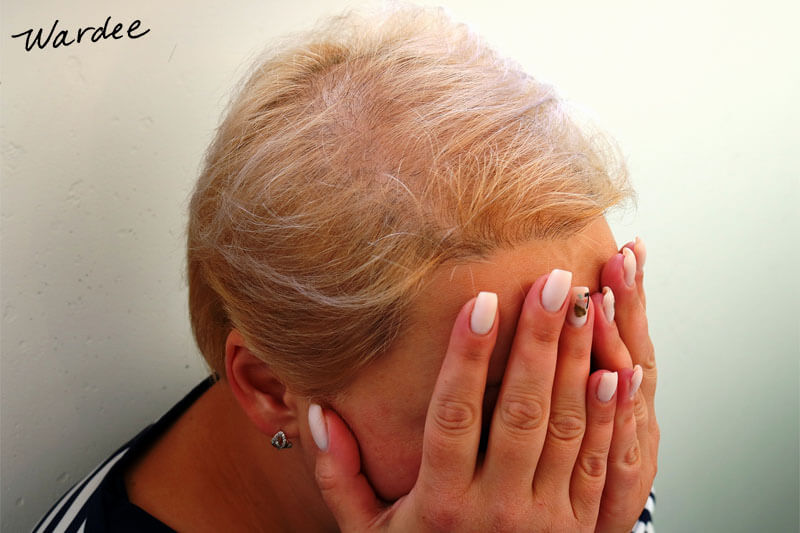
The Hair Loss Industry
Rob spent six years and over $10,000 on hair loss products that looked promising and were well marketed… but turned out to be scientifically baseless.
Hair loss is one of the only industries whereby profit incentives disadvantage consumers at multiple levels — online, at the doctor’s office, at a dermatologist appointment, etc. — and for different reasons.
Online
Online, someone researching hair loss will find high-ranking, popular health websites on Google that link to studies and claim to be medically reviewed, but don’t tell the whole story. Instead, they are incentivized to push a part of the truth to consumers and then link to affiliate supplements that supposedly solve your problem.
One example is biotin, a commonly touted cause of hair loss. Certainly, biotin deficiencies are associated with hair loss. In some cases, they’re causally linked to hair loss.
But the study cited was on children in the developing world who have something known as a bio-tinnitus deficiency, a genetic mutation that occurs in one out of 110,000 individuals to the severity by which it will actually trigger hair shedding. When these children receive biotin, they overstep that enzymatic deficiency and can begin to grow hair normally.
Biotin supplements for hair loss sell hundreds of millions of dollars every year… but this is a supplement for a very specific type of hair loss, and popular health websites are communicating it outward to the general population, where in most cases, it does not apply.
n fact, according to Rob, if you have male or female pattern hair loss, the likelihood of you benefiting from a biotin supplement is almost non-existent in most cases.
At the Doctor’s Office
If someone asks their doctor about options for hair loss instead, they are also met with misaligned incentives. Doctors are incentivized to see as many patients as possible each day to keep their doors open. This means short appointment times for patients and burn-out for doctors.
In 2019, most doctors worked just shy of 60 hours per week. Family physicians cared for a panel of 2300 patients, on average. New physician-patient time is a mere 8 minutes. And physician burnout was at almost 50%.
Yet in order for a doctor to fully evaluate a patient’s hair loss, they need to spend a lot of time with that patient. They need to do a full health evaluation to determine if hair loss might relate back to subclinical hypothyroidism, a low-grade widespread nutritional deficiency, or gut dysbiosis.
Instead, patient interaction is so limited, and the doctor usually ends up prescribing drugs like Propecia and minoxidil. These drugs can absolutely work for a majority of cases, but inevitably, some patients will solve for just a portion of their hair loss equation and get underwhelming results without understanding why. That was Rob’s experience.
At the Dermatologist’s
Some might forego the online research and the doctor’s office altogether, and go straight to the cream of the crop: a dermatologist specializing in hair loss disorders. And yet, according to Rob, dermatologists also have a set of profit incentives misaligned with patients.
They keep their doors open by offering hair loss patients clinically-backed treatments like platelet-rich plasma therapy, stem cell therapy, etc. The data suggests these treatments increase hair counts, on average, by 30%. But they cost anywhere from $1,000 to $10,000, and their results are contingent upon lifetime use.
What the dermatologists won’t tell you is that clinical studies demonstrate that micro-needling can offer roughly the same results! Micro-needling devices are available online for literally $10 (like here).
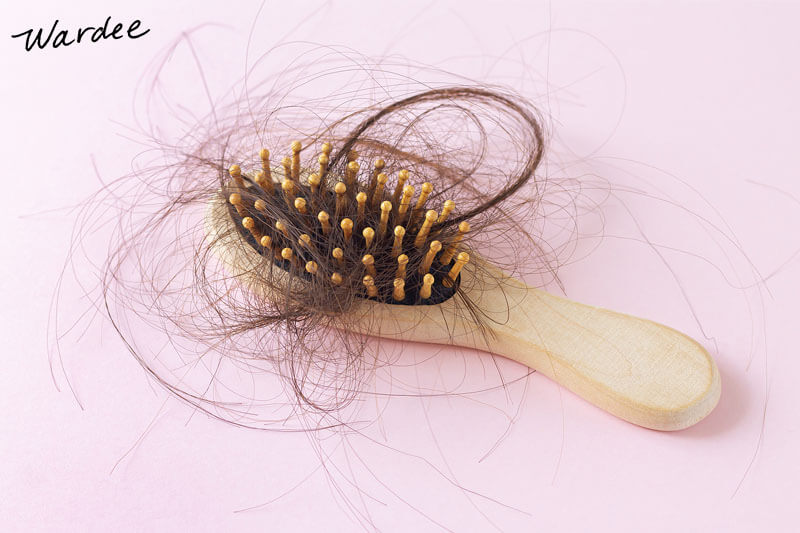
Types and Causes of Hair Loss
Since different types of hair loss respond to different kinds of treatment, it is critical to identify why hair loss is happening in the first place, before intervening. Not only would it be a waste of time and money to try the wrong treatment, but you risk losing more hair in the meantime. It is much easier to prevent the progression of male and female pattern hair loss than it is to reverse it in its end stages.
So, what are the different types of hair loss? According to Rob, there are really two.
1. Androgenic Alopecia
This is male and female pattern hair loss — a chronic, progressive disorder caused by genetic predisposition.
In men, it typically begins as temple recession and a bald spot on the back of the head follows. In women, however, it presents a little differently. Rarely will it progress to the point of a woman being completely bald, but her hair will thin throughout the entire top of her scalp.
The defining characteristic of this type of hair loss is hair follicle miniaturization. The hair strands themselves become thinner over time. Someone with this disorder will notice that the hairs they shed are of different thicknesses.
Eventually, new research linked the testosterone metabolite DHT to androgenic alopecia, which is why the drug Propecia is recommended for hair loss. It reduces the activity of a certain enzyme (type 2, 5-alpha-reductase) that converts testosterone into dihydrotestosterone, or DHT.
Women with polycystic ovarian syndrome (PCOS) are more likely to suffer from androgenic alopecia due to androgen exposure. (Learn more about PCOS, the most common endocrine and reproductive disorder among women, here!)
2. Hair Shedding Disorders (Telogen Effluvium)
This type of hair loss occurs when our hair cycle gets disrupted.
Every two to seven years every hair on our head will grow, then stop growing, then disconnect from its follicular base and shed out. The old follicle then collapses, and a new one regenerates to take its place. This is our hair cycle, and it is closely related to a very delicate balance between hormones and proteins in our scalp skin.
If something happens to dysregulate those hormones and proteins, excessive numbers of hairs can shed prematurely, creating a gap between when all of the hairs shed, and when new hairs come in to take their place. The event that triggers these sheds typically occurs three to five months prior to when someone notices hair shedding. It takes time not only for the hair follicles to react and disconnect but also for the hairs to inch out of the scalp before they finally fall.
Thankfully, these types of hair loss are almost always temporary. According to Rob, if you can identify their underlying cause, you can treat the hair loss. Within about three to eight months, the hair cycle restarts. After a year or two, it’s as if you never lost any hair to begin with — it all grows back!
Possible causes of dysregulation include:
- stress, whether physiological or psychological, trauma-related or surgery-related, etc.
- nutrient imbalances, such as Vitamin D deficiency, low iron levels, Vitamin B12 deficiencies, selenium imbalances
- hypothyroidism
- heavy metal toxicities
- gut dysbiosis, including SIBO
When the Two Coincide
Finally, there seems to be some interaction between the two types of hair loss.
In the absence of telogen effluvium, male and female pattern hair loss progresses slowly, over years to decades. But if a person with a genetic predisposition for androgenic alopecia has low-grade nutritional deficiencies, chronic conditions such as hypothyroidism, gut dysbiosis, etc., and isn’t actively taking steps to address these, then the hair cycle can start to dysregulate resulting in acceleration of hair shedding. This phenomenon is known as telogen effluvium unmasking androgenic alopecia.
If you’re suddenly faced with extreme hair loss that’s a certain thickness, then next time it’s thinner, you probably fall into this category.
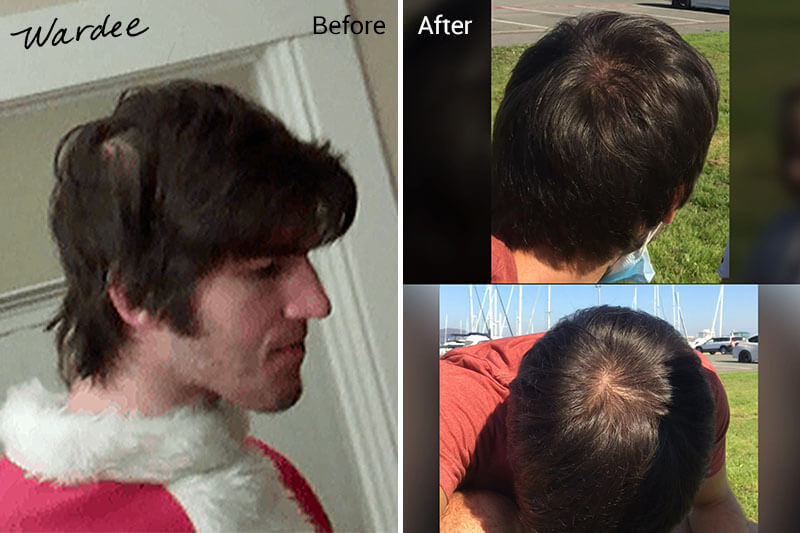
Reversing Hair Loss: Rob’s Story
Rob sought treatment in 2007 when he was first diagnosed with androgenic alopecia. Over the next four years, he tried minoxidil, an 8-week trial of low-level laser therapy, different dietary interventions and supplements (including saw palmetto), different combs and devices… but his hair loss continued to slowly worsen.
Eventually, he stumbled upon the idea of using the body’s own innate wound-healing responses to address hair loss. This research suggested that massages and micro-needling — treatments that have a similar mechanistic overlap to platelet-rich plasma therapy and other acute wound exercises offered by dermatologists — had a clinical basis.
Over the next eight to ten months, Rob’s hair started to significantly thicken as a result of massage, micro-needling, and other simulation-based therapies (more on these, below). He kept it up for the next several years. Now he estimates that he has re-grown probably 50% of the hair he lost, which is amazing!
Rob wants us to know, though, that his hair loss was not nearly severe as it could have been. So 50% recovery is relative to the absolute amount of hair he lost, which was relatively minimal.
Still, as you can see in the photos, his results are noticeable and significant!

Lifestyle and Environmental Interventions
If you want to target hair loss effectively, your approach has to be multifaceted.
We’ve already discussed conventional treatments of hair loss, including pharmaceuticals like Propecia and minoxidil. If you are comfortable with them, they are clinically tested and can be effective if you have androgenic alopecia.
If you and your provider think your hair loss might be related to telogen effluvium, either by itself or with underlying androgenic alopecia, then to see significant improvement you might need to look into alternative treatment methods, as well.
As Rob says, if you’re dealing with pattern hair loss, lifestyle and environmental interventions won’t be enough to stop it from progressing (most likely). But that doesn’t mean that you shouldn’t be targeting these things to help normalize hair cycling, and/or maximize overall health!
So, let’s dive into the dietary and lifestyle changes that impact our hair health.
- Nutrient repletion. As mentioned above, Vitamins D and B12, selenium, and iron are all important for healthy hair. Get outside in the sun!
- Avoid allergenic or inflammatory foods. This is specific to each individual.
- Eat enough protein. Many women are deficient in protein, which is one of the causes of hair shedding.
- Get eight hours of sleep each night. Studies show that men who sleep for six hours vs. eight hours per night have testosterone levels that are ten years older than their biological age. They also have higher cortisol levels, insulin insensitivity, and are more susceptible to weight gain. Sleep is critical for all biological processes, including hair.
- Move daily. Lack of movement can lead to insulin resistance over time and inhibits digestion. Every 45 minutes to an hour, especially right after a meal, get up and take a walk for ten to 15 minutes.
Alternative Holistic Therapies for Hair Loss
Rob also shared natural interventions that can be very effective for hair loss. Although there isn’t as much research on these simulation-based therapies as the pharmaceuticals shared above, the scientific evidence is promising.
These holistic interventions include…
- Scalp massage. 75% of individuals performing daily scalp massage for eight months or longer report a stabilization of hair loss or hair regrowth, with the degree of hair regrowth varying depending on the person (source).
- Micro-needling. This therapy helps stimulate new growth factors to kickstart the hair cycle across the top of the scalp.
- Saw palmetto. This supplement comes from the Serenoa repens plant and helps to lower DHT levels. It works about half as well as Propecia and its half-life in the body is shorter. Some clinical studies suggest that over a one to two-year period of using saw palmetto, 90% of men can see some degree of cessation or improvement in their thinning hair.
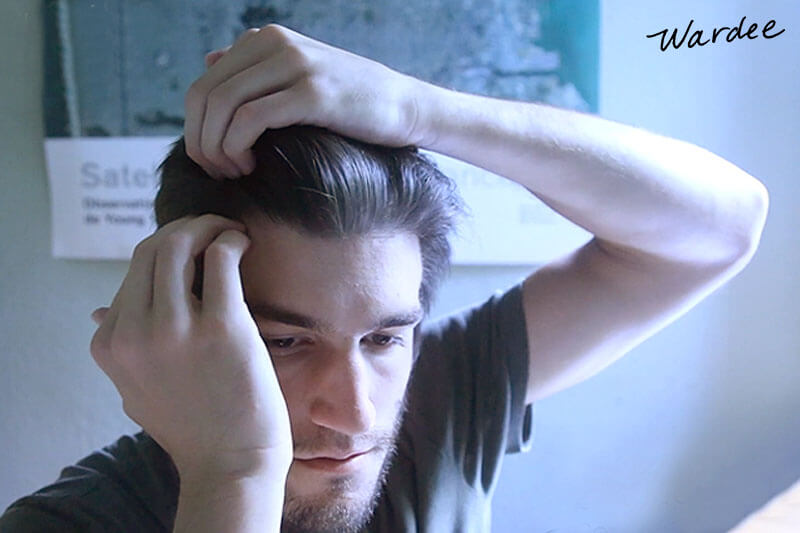
Head Massage for Hair Growth: The Evidence
Scalp massage is therapeutic, relaxing, and stress-relieving. Yet… does it work?
In Rob’s experience, yes. But he didn’t leave it at that. Perfect Hair Health launched a study to determine how massage-based modalities were working for other hair loss sufferers.
The study spanned a period of several years. Rob provided participants with a video demonstration and PDF instruction manual explaining how to do regular scalp massages. Participants self-reported how long they massaged every day, how regularly they massaged, and their results.
The data was definitive: The longer, more often, and more consistently people massaged, the happier they were with their results. You can check out Rob’s website for before and after photos from people employing stimulation-based therapies such as scalp massage.
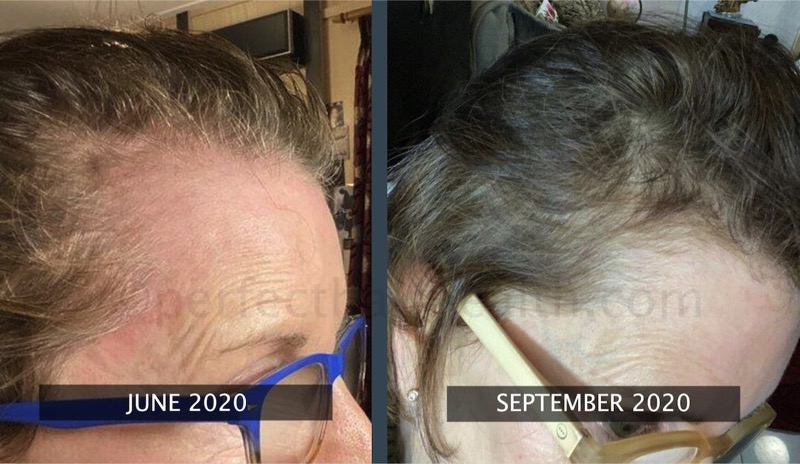
How to Massage Your Scalp
Rob generously offers his video and PDF instructions for free. In them, you will find detailed explanations of how to do head massage for hair growth!
Frequently Asked Questions for Scalp Massage
How Often Should You Massage Your Scalp?
Rob recommends two 20-minute massage sessions daily, once in the morning and once at night.
Does Head Massage Cause Hair Loss?
According to Rob, it’s normal to see some shedding during massage… but nothing should fall out that wouldn’t already be falling out during the course of the day. Even without pattern hair loss, it’s normal to lose about 100+ hairs a day.
If you notice your hair looking visibly thinner as a result of massaging, it’s time to reevaluate your technique.
How Long Does It Take for Scalp Massage to Regrow Hair?
Hair grows slowly. No matter what treatment option you try, you have to be willing to give it time!
With pharmaceuticals, Rob recommends trying whichever one you choose for four to eight months at a minimum.
For natural interventions, it may take eight to 12 months to see results. If you don’t notice any improvement after a year, you’ll probably need to switch things up.
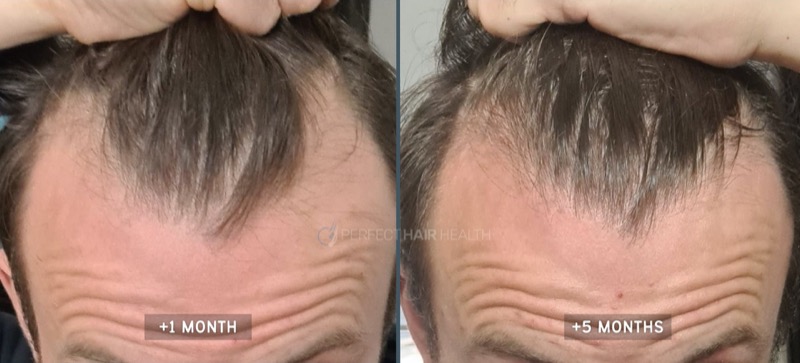
How Does Head Massage Promote Hair Growth?
Based on the data, Rob suspects that scalp massage works through two mechanisms.
1. Massage Generates Inflammation
Massage generates inflammation across the top of the scalp. Inflammation, when it’s generated acutely through firm pinching, pressing, and stretching, can initiate a wound healing response. In this way, the body sends proteins to the scalp to help stimulate a new growth stage of the hair cycle.
In male and female pattern hair loss, scar tissue often begins to entrap the hair follicles. This makes it more difficult for the hair follicles to resize as larger when you’re trying to treat hair loss. This is similar to micro-needling, which also helps to diminish scar tissue, making it a popular treatment for those trying to heal scarring from acne.
So, as Rob explained, there is a short-term benefit to this first mechanism (stimulating new growth) and a long-term benefit, as well (reducing scarring).
2. Massage Relaxes the Perimeter Scalp Muscles
Massage helps to relax the muscles around the scalp. There are no muscles across the scalp, but there are around its perimeter. According to dermatologists, 80% of the patients with male and female pattern hair loss have tight scalps. In other words, their scalp perimeter muscles are contracted.
In 2010, a research group injected BOTOX around the scalp perimeter for participants suffering from tension headaches. It inadvertently improved pattern hair loss outcomes!
In a following clinical study, 75% of participants had positive results when their scalp perimeter muscles were injected with BOTOX twice in ten months. Of the participants, there was an average 18% increase in hair counts. Since then, more studies have confirmed that injecting the scalp perimeter muscles leads to about a 75% to 80% positive response rate and a 15% to 20% increase in hair count.
Rob sums why it’s important to have relaxed scalp perimeter muscles for healthy hair…
To reach the top of the scalp, blood pumps from the heart through the perimeter scalp muscles, passing through the carotid arterial branches. If these muscles are chronically contracted, they can pinch the blood vessels and reduce blood supply. There were even studies in the 1990s that demonstrated that balding scalps have a lower blood supply than non-balding scalps!
Finally, the data suggests that it’s possible to take these muscles out of chronic contraction just by gently massaging the surrounding perimeter of the scalp with one’s fingertips.
At the very least, scalp massage is relaxing! At the very most, it stimulates hair regrowth, reduces scar tissue, and increases blood supply for healthy hair and scalp.

Recommended Resources
Again, an encouragement if you’re reading this and using the non-toxic hair regrowth products I recommend (and use myself): they work very well with what Rob shared here. Go here to see.
Be sure to check out Rob’s website, Perfect Hair Health, for more hair resources including how hair loss relates to the microbiome (and much more)! He offers a 10-day email course on hair regrowth with or without drugs.
Or, get in touch personally through his membership community. You can also see many success stories there (including amazing before and after photos).
Through his membership community ($50 off through this link), Rob has helped hundreds of men and women regrow thinning hair. He helps individuals figure out and address their own unique causes for hair loss… it’s not one size fits all!
If you decide to join his program, you’ll not only get $50 off through this link, you’ll gain access to a 220+ page book on hair recovery, 130+ hair regrowth regimens tailored to your needs and preferences, 50+ reader case studies, a before-after photo vault, 30+ ultimate guides, over a dozen product reviews (with laboratory testing!), an exclusive forum, and more.
Click here for more info and $50 OFF the “Perfect Hair Health” membership community.
You can also check out my other related resources on Wardee.com by following the links below!
- What To Do For Thinning Hair +Great Hair EVERY Day! (my tips and recommendations… now adding massage to the list!)
- See if the hair regrowth products I use and recommend might work for you, too
- How To Take Care Of Curly Hair & The Best Way To Style It
- Everything You Need to Know About PCOS + How to Treat It Without Birth Control
- 10 Ways To Look Younger… without toxic lotions or creams! (free eBook from me)
- Inexpensive Micro-Needling Device (for scalp and face)
Are you experiencing hair loss? What has or hasn’t worked for you?
Answer in the comments!


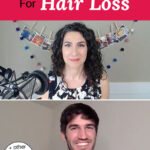

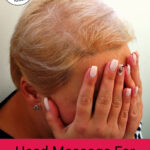


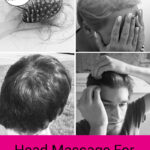

Leave a Reply